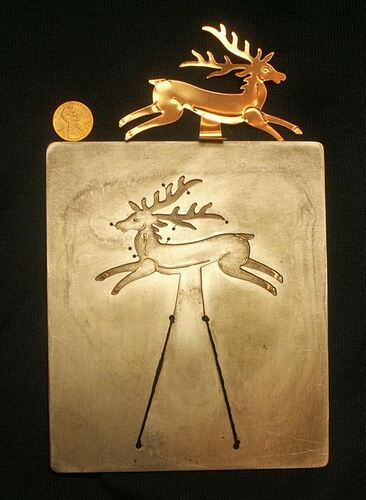I wanted to post this to my sheltech blog but I’ve found I can
nolonger log in to it. I haven’t looked into why not, because I get
very lazy and disinterested with computers when they don’t
cooperate. maybe the blog program no longer supports Ie ???, well,
my XP only goes to IE 8 and not Ie, so… whatever, I have the pics
posted on my photobucket site. Which also is lame, because it didn’t
allow more than a 2048 -charachter description. So, bearing with
me-- I’m very, very good at making pancakedies, so it’s worth a few
minutes to anyone interested – the full description is here, and
the pictures are there.
This is a one-piece die that cuts and embosses in one pressing. The
copper sample is 26ga. (.016") ; the embossing wires are 24 ga.
nickel silver (round), super-easy-silver-soldered to the face of the
die. When pressing, the die is placed on a solid nylon block ;
specifically nylon because, a) it isstiff and solid enough to fully
support the delicate parts of the die for cutting (essential for
pancake dies in general and particularly important with a design
like this), and b) nylon is soft enough under pressure
(extrapressure directed to the wires once the part is cut) to
temporarily conform to the wire designs. The copper is thin and soft
enough to become embossed as it is sandwiched between the die and
the nylon with about 15 tons ofpressure.
The many extra holes drilled in the die are ‘cheater’ holes drilled
so that I didn’t have to feed a fresh sawblade through every part
I’d already sawed every time a blade broke. This die is made of
5/64" thick heat treated tool steel ; I used size 3/0 Pike Platinum
blades, the best brand for this work, but a bit brittle sometimes
(made hard to cut hard metals), and so I went through a lot of
blades on this die. I used the 5/64" steel and 3/0 blades because it
allowed me to set the die plate at a lesser angle while sawing,
which leaves thin, delicate areas that have more mass than when cut
with larger blades at a more actue angle. Pancake dies are supposed
to work, and when you set the sawing angle correctly, they are
capable of cutting thin metals (26ga and thinner) quite neatly. The
5/64" steel is thick enough to cut 16 ga. but I wouldn’t let as
intricate a die as this to cut metal that thick, because of the risk
of failure, and it wouldn’t emboss metal so thick, anyway.
The sample shown was actually pressed a second time, to flatten the
piece, without taking away the lines. This type of line embossing
puts the wires in direct contact with what is technically the back
side of the cut piece, and thin metal like 26 or 24 ga is typically
used because it is thin enough so that the sheet metal is actually
bending and conforming, as opposed to pressing the same wires into
say, 16 ga, where such thick metal would not bend around suchsmall
diameter wires. instead, the lines would be pressed into the
surfaceof the metal while the piece itself would remain flat. That
second scenario is what happens in coining, and the thin nickel
silver wire designs like those shown here are not strong enough to
hold up to that for long term use.
So, normally, this embossing pushes designs up from the back, so the
front of the piece ends up with more muted lines than this piece
shows, because this piece is shown from what is technically theback
side, the side that the wires contact directly in the press. This
sharpness is what the client (Haw Creek Forge, makers of some very
nice garden art in North Carolina) wanted. So the back of the piece
becomes the front, and the flattening out in the second pressing,
done against the same solid nylon block at a somewhat lower
pressure, leaves the piece looking much like a piece that was cut
flat and had lines stamped in by hand (or a part that was made by a
very expensive industrial production setup). Here’s the link, which
I suspect will not be posted functionally, in which case it’s at
photobucket dot com, and look for sheltech’s library, and the ‘dies
and parts’ album, and the picture titled ‘Stag Die a’
Dar
